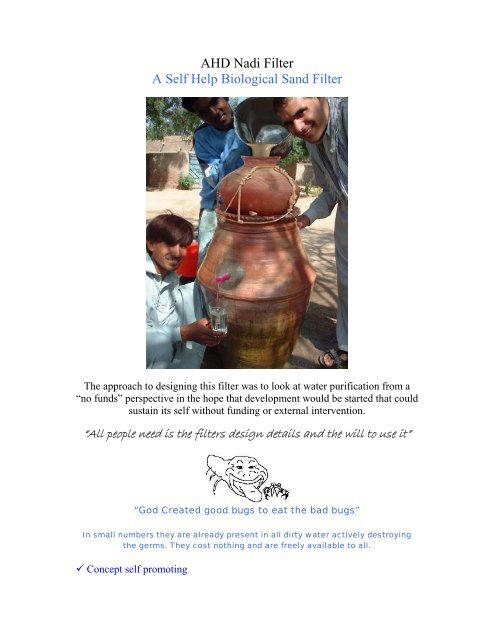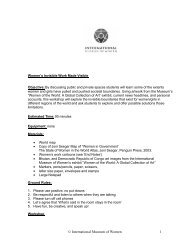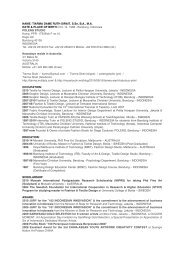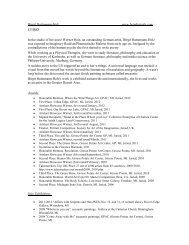AHD Nadi Filter A Self Help Biological Sand Filter
AHD Nadi Filter A Self Help Biological Sand Filter
AHD Nadi Filter A Self Help Biological Sand Filter
You also want an ePaper? Increase the reach of your titles
YUMPU automatically turns print PDFs into web optimized ePapers that Google loves.
<strong>AHD</strong> <strong>Nadi</strong> <strong>Filter</strong>A <strong>Self</strong> <strong>Help</strong> <strong>Biological</strong> <strong>Sand</strong> <strong>Filter</strong>The approach to designing this filter was to look at water purification from a“no funds” perspective in the hope that development would be started that couldsustain its self without funding or external intervention.“All people need is the filters design details and the will to use it”“God Created good bugs to eat the bad bugs”In small numbers they are already present in all dirty water actively destroyingthe germs. They cost nothing and are freely available to all. Concept self promoting
1. An invitation to the village is acquired2. Motivational training is given which includes:• water and hygiene• how the filter works• how to make the filter3. A filter is then made by the village people themselves undersupervision.4. The trainers leave once a filter is operating and can beexplained, maintained and replicated by the peoplethemselves.Base Line Survey:No expense is required for a base line survey because it isbroadly accepted that the filters provide clean water and that clean water results inimprovements to health. The Base line is simply the fact that there are originally no filtersbeing used. Progress can be assessed after a chosen period by randomly selecting villages inthe target area and counting the number of functioning filters.How the <strong>Nadi</strong> filter worksThe filter is simply an optimised residence for the “good microbes” that eat up the microbesthat cause diseases. The filter is designed to protect the good microbes in the sand whichwould be destroyed if the sand was allowed to be churned up or drained of water. Theyrequire a stable surface to live on with a constant supply of dirty water and oxygen to feedon. The sand in the filter provides an enormous surface area for them to live on and theymultiply to fill this space. This takes two to three weeks to establish. In the mean time thewater is far better than before even after a day or two.Parallels of Bio sand filtersGood microbes capable of cleaning water are freely available to all as they occur naturally indirty water. God mercifully created these organisms knowing that we would mess up ourdrinking water and need help to get it clean again. Sickness and poor quality of life, evendeath can result from not using these God given organisms. The filter was designed with thisin mind.
The big difference is if people believe and accept God’s gift of the filter their lives will beimproved.<strong>Nadi</strong> <strong>Filter</strong> Design SpecificationsThe nadi used for the filter must be 32 to 34 inchestall.A hole is made for the pipe in the side of the nadiusing a screwdriver and a suitable stone or hammer.The bottom of the hole must be 20 inches above theground.A single piece of stiff flexible pipe 30 inch long, 1inch diameter and with no splits in it is fitted throughthe hole with one end inside the nadi touching thebottom. It is put in place and the hole around the pipemade water tight with cement.A water storage pot for the filtered water must bechosen. If it is a nadi with a tap it should be put uphigh enough for jug to go under its tap. Put this cleanwater storage nadi on enough bricks to make thispossible. The filter nadi can then be put in place onenough bricks for the protruding pipe to be just abovethe top of the storage nadi.Potato size washed stones are placed in a single layer one stone deep at the bottom of thenadi. The gaps between them form channels for the water to flow easily into the pipe.Small washed stones are placed on top filling the gaps between the potato size stones.Enough should be placed to prevent the next layer of gravel from falling through andblocking the gaps under the potato size stones or clogging up the pipe.A thin layer of washed, dhal size gravel is then spread to form a level surface over the smallstones.A thin layer of washed seed size gravel in then spread to form a level surface over the dhalsize gravel.These drainage layers must not exceed 4 inches in total thickness or there will not be enoughroom for the main material, the sand.Washed sand is then added to a level 5 inches below the level where the bottom of the pipegoes through the side of the nadi.The mutca is taken and a single hole is drilled in it using a 3 or 4 inch nail with a right anglebend in it to form a handle. At first this is difficult work but after a few minutes the hole ismade without the need to hit it through with a hammer. Most screw drivers make holes that
are a bit too large so a nail is better. The hole should be on the bottom of the mutca about 4inches to one side so as not to get blocked too frequently by debris settling in the mutca.The mutca is then tied in place on top of the nadi with the hole in the mutca in line with thepipe coming out of the nadi. A stone is wedged between the mutca and nadi so that the holein the mutca can be seen and it is easy to notice if the hole becomes blocked. String must beused to fix the mutca in place in order to protect the good microbes in the nadi from beingdisturbed.A cloth is tied over the mouth of the clean water storage nadi in such a way that the cloth isover the protruding pipe. The water should not be flowing onto the cloth at all, as this wouldre-contaminate the clean water.Once dirty water has been given to the nadi every day for two to three weeks the filter willfunction effectively so long as the sand is not disturbed. During this period the water willgradually improve. If the sand and stones were well washed, water can be improved a littleby the filter even on the first day.The nadi for storing clean water should be emptied every three days during this initial periodwhile water quality is rapidly improving.Pots for storing clean water should never be used for collecting dirty water.When using a new nadi to make a filter it should be first checked for leaks which should berepaired using cement.Never completely fill a new nadi or small cracks will develop. Only half fill it with water atfirst, then after two or three hours fill it completely and check for leaks.If the filter gets too slow or stops working, remove the top few inches of sand from inside thenadi. Wash this sand with water in a bucket or bowl then put it back in the nadi. Make surethat the level of the sand in the nadi is restored to 5 inches below the bottom of the pipewhere it comes through the side of the nadi.When it becomes necessary to clean the sand in the filter it is good if there is another filter inthe community that can be used for the two or three weeks it takes for the filter to build up itsnumbers of good microbes after being cleaned. Dirty water used for starting off a new orrecently cleaned nadi can be put through the new one then through an established one if it isnecessary to drink this water.Project funding requirements:Trainer’s wages
Transport for trainers (Big jeep)Materials for training:<strong>Nadi</strong>Mutca<strong>Sand</strong>CementMesh in three sizesMesh cutterScrewdriver and hammerPlastic pipeStringNailsSacksStationaryLightsCamera for record keepingOffice support staff costsSenior staff supervisioncostsCost of making a<strong>Nadi</strong> <strong>Filter</strong>32- 34 inch <strong>Nadi</strong> 150 Rs- 200 Rs*20 inch <strong>Nadi</strong> 100 Rs- 125 RsMutca 35 Rs - 50 Rs<strong>Sand</strong> 35 Rs - 50 RsPipe 45 RS - 55 RsCement 15 Rs - 25 RsString 10 Rs - 20 Rs*Bricks 20 Rs - 30 RsTotal 410 Rs - 555 Rs Typically 450 Rs* Not essentialFurther information please contacts:Association for Humanitarian Development (<strong>AHD</strong>)House # 60/A, Block-C, Unit No. 06, LatifabadP. O. Box # 1094, Latifabad 71800, HyderabadSindh, PakistanPh: +92-22-2933236, & 8330582
E-mail: ahdpak@yahoo.comWebsite: www.ahdpak.orgContact persons:Mr. A. Khurshid BhattiMr. Iqbal Hussain MemonPresidentCoordinator, Agriculture ProgramCell: +92-0333-2661682 Cell: +92-0300-3069344E-mail: ahdpak@yahoo.comE-mail: ahdpak@yahoo.com








